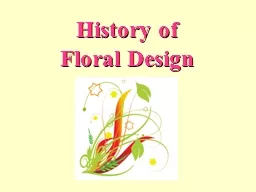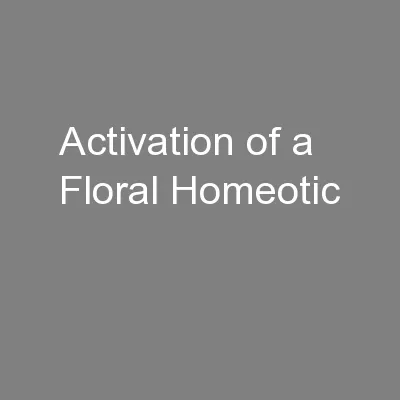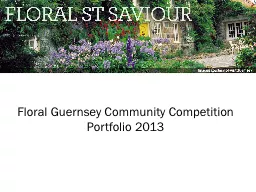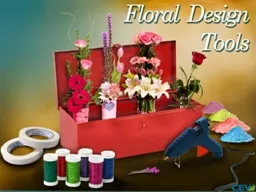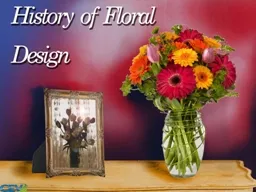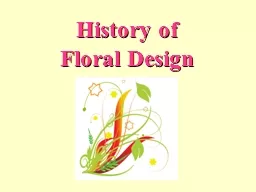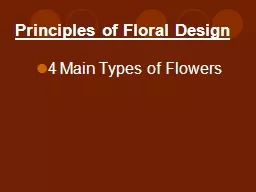PPT-History of Floral Design
Author : yoshiko-marsland | Published Date : 2016-06-09
Why is it important To create arrangements with the feel of another time and place To harmonize your arrangements with the time period of the room or building HISTORY
Presentation Embed Code
Download Presentation
Download Presentation The PPT/PDF document "History of Floral Design" is the property of its rightful owner. Permission is granted to download and print the materials on this website for personal, non-commercial use only, and to display it on your personal computer provided you do not modify the materials and that you retain all copyright notices contained in the materials. By downloading content from our website, you accept the terms of this agreement.
History of Floral Design: Transcript
Why is it important To create arrangements with the feel of another time and place To harmonize your arrangements with the time period of the room or building HISTORY REPEATS ITSELF Floral Design in Ancient Civilizations. Designs. First things First!. Materials. Fresh floral material(carnations, baby’s breath, backer’s fern). Floral Container. Floral Foam (Oasis). Florist wire and wire cutters. Sharp florist Knife. The directly observable components, ingredients, and physical characteristics of a design.. Elements of Floral Design. . . Line. Form. Space. Texture. Pattern. Fragrance. Size. Color. Line. . Gene in . Arabidopsis. Maximilian A. Busch,* Kirsten Bomblies,* Detlef Weigel†. Presentation by . Steven Wang and Clemens Langemeyer. Content:. Introduction. Objective(s) / Hypothesis . What do we know?. Portfolio 2013. Our . organisation. structure and volunteers. This is the fourth year since our . current Community . Entry . Team took over the St . Saviour. entry. We have a small committee that . To identify floral design tools.. To describe the use of adhesives in floral designs.. To discuss different products necessary to floral design.. 2. Main Menu. Knives & Scissors. Wire Cutters. Florist/Pruning Shears. Floral and Lighting Design. The Big Event Production and Entertainment. The Big Event Productions and Entertainment specializes in artistic and creative floral and lighting design services for your wedding, anniversary, and other life celebrations. Our designs are inspired by your personal style and imagination!. Warm Colors: red, orange, yellow. associated with sun, heat, and fire. evoke warm and happy feelings. warm colors will dominate when in an arrangement. Cool Colors: blue, green, violet. associated with grass, water, ice. Robert Parker’s . WINE ADVOCATE. a. rgylewinery.com. 91. points. 2009 . ARGYLE Brut Rosé. Willamette Valley, OR. “Strikingly . redolent of a florist’s shop in its combination of illusive floral perfume with greenery, as well as intimating the cherry, red raspberry, and almond paste that then lusciously and buoyantly inform the . To analyze the history of floral design.. To discover the developments of floral design.. To evaluate the significance of floral design.. 2. Table of Contents. Significance of Floral Design. Oriental Influence on Floral Design. Learning Targets. 1. . I can list . and describe the major forms (or shapes) used in floral design.. 2. . I can explain . how space and depth enhance floral design.. 3. . I can describe . the importance of texture in floral design.. Why is it important?. To create arrangements with the feel of another time and place.. To harmonize your arrangements with the time period of the room or building.. HISTORY REPEATS ITSELF!!!. Floral Design in Ancient Civilizations. Floral Design Essential Standard 7.00: Understand floral design Design Materials Four Basic Types of Design Materials Line Flowers Mass Flowers Form Flowers Filler Flowers Line Flowers Line Flowers (and foliage)- create height, width and a balanced look in the arrangement. Line flowers are attractive by themselves in a tall vase. They produce floret blooms on tall spikes 4 Main Types of Flowers. Line flowers. Long, slender spikes of blossoms with flowers blooming along the stem.. Can also include bare stems.. Used to establish the skeleton or outline of the arrangement.. Adeetya's Kitchen & Furniture in Pune offers exquisite handmade furniture designs with superior craftsmanship and modern, stylish appeal. https://adeetyas.com/factory-made-furniture-design-in-pune.php
Download Rules Of Document
"History of Floral Design"The content belongs to its owner. You may download and print it for personal use, without modification, and keep all copyright notices. By downloading, you agree to these terms.
Related Documents

